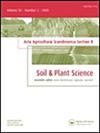两种土壤中稻草和金合欢生物炭对磷有效性的优化
IF 1.8
4区 农林科学
Q2 AGRONOMY
Acta Agriculturae Scandinavica Section B-Soil and Plant Science
Pub Date : 2023-09-11
DOI:10.1080/09064710.2023.2248998
引用次数: 0
摘要
本文章由计算机程序翻译,如有差异,请以英文原文为准。
Optimisation of rice straw and acacia biochar doses in two soils for phosphorus availability
ABSTRACT Biochar (BC) is a soil fertility enhancer, regarded as a potential carbon sequester and nutrient leaching preventer. Various studies have shown better phosphorus (P) availability with adding biochar. However, limited reporting is available on absorption–desorption behaviour of added P and dose optimisation of biochar. Rice straw biochar (RSB) and acacia biochar (ACB), prepared by slow pyrolysis at optimised temperature and pyrolysis time, were incubated at different rates (0, 5, and 10 g kg−1) in loamy sand and clay loam soils to study P sorption compared to the unamended control. The data was observed to be best fitted into Langmuir adsorption isotherm for P adsorption. The effects on maximum P adsorption, bonding energy, and adsorption rate constants were lower in loamy sand compared to clay loam soil. The values of maximum P desorption (Dm) and desorption rate constant (Kd) decreased with the application of biochar. A linear regression equation optimised the amount of P addition for soil amendments. For the soil with inherent P content, rice biochar was the best option (5 g kg−1), while for soils lacking in P, ACB is optimised at 5 g kg−1 with external P input of 1 mg P kg−1 of test soil. This data can be recommended to the farmers as a best practice for the P addition, along with managing farm wastes as biochars to enhance nutrient availability.
求助全文
通过发布文献求助,成功后即可免费获取论文全文。
去求助
来源期刊
CiteScore
4.40
自引率
0.00%
发文量
56
审稿时长
2.3 months
期刊介绍:
Acta Agriculturæ Scandinavica Section B publishes original research in applied soil and plant science with special attention given to to crop production in agri- and horticultural systems. We welcome manuscripts dealing with:
Climate smart and sustainable crop production systems
Water and nutrient efficiency
Soil conservation and productivity
Precise agriculture systems
Applications of bio- and nanotechnology
Digitalisation and robotics
Soil-plant interactions
Acta Agriculturæ Scandinavica, Section B – Soil & Plant Science forms part of a series of titles published on behalf of the Nordic Association of Agricultural Science (NJF). The series also includes Section A - Animal Science .

 求助内容:
求助内容: 应助结果提醒方式:
应助结果提醒方式:


